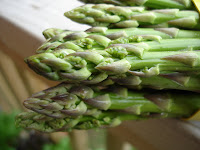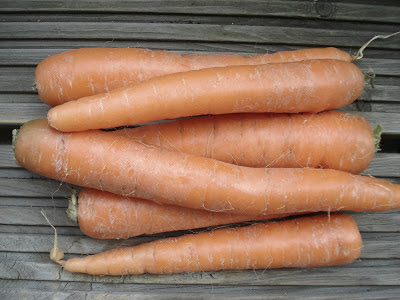Benny loves Joon
What's not to love about the month of June? The warm weather is definitely here to stay, summer will officially begin with the solstice, and it's a veritable cornucopia for the seasonal food lover! Lobsters, crabs, shrimps and other lovely creatures from the sea are arriving at the market. Also, many of you will be setting up your barbecues -if it isn't done already- and everything thrown on the grill is absolutely delightful!
What to look for in June:
Asparagus
The heat wave has let up, and most regions across Canada have gotten a little rain, so asparagus season might just about stretch out to its usual mid- to late June.
I cannot go on enough about all the wonderful ways to enjoy asparagus! Steamed with a light dressing or a dollop of mayonnaise; in a creamy soup, hot or cold; with pasta, a small knob of butter and generous shavings of Parmesan... There is nothing like the delicate nuttiness of asparagus to make one go cuckoo!
I cannot go on enough about all the wonderful ways to enjoy asparagus! Steamed with a light dressing or a dollop of mayonnaise; in a creamy soup, hot or cold; with pasta, a small knob of butter and generous shavings of Parmesan... There is nothing like the delicate nuttiness of asparagus to make one go cuckoo!
For those of you who are beginning to tire of asparagus, or are seeking new ways to indulge in them, try them on the grill (straight, no oil, covered for about 5 minutes over high heat, or until slightly charred), then drizzled with olive oil and some lemon juice or balsamic vinegar. It will win over even the most hardened asparagus hater!
If you, like me, depend on the kindness of others for access to a barbecue, try roasting them in the oven: 180'C/ 425'F, drizzle with oil, 10 minutes. DIVINE! Leftovers (rather unlikely) can go in a salad, on a pizza, or on an open-faced sandwich with a creamy goat cheese and arugula.
Radishes
While the heat in May made for some piquant radishes, the cooler weather and occasional rain in June has produced plump, juicy and mild roots. If you are still not convinced you want to risk the peppery vapours up your nose, try cooking the little devils: I have previously enjoyed radishes sautéed in butter, greens and all, so I recently tried them on the barbecue along with some asparagus. The result was surprisingly tasty, though next time I will try grilling the greens separately, or cutting the roots in half. In any case, cooking radishes rids them of their fire, leaving them juicy with flavour. Just make sure you wash them in a generous amount of water (throw out the wash water in the garden!), because any trace of grit is a major turn off.
Baby root vegetables are a great way to hone your palate: if you were never a fan of turnips or beets, you should try them as baby veg. They are much milder than their full-sized counterparts, and being smaller, they are less of a challenge to eat. They tend to be more watery then adult roots (read: very juicy), tender under the tooth (more give than crunch), and are the ideal size for children.
Thoroughly washed, they can be eaten greens and all either sautéed in a pan with butter or oil, roasted in the oven, or grilled. They don't even need to be peeled like the bigger roots! Throw a bunch of radishes, beets and turnips in the oven to roast or on the barbecue to grill, and you have a sublime warm salad for dinner.
Spring onions (green onions)
Onion greens are available year-round for a relatively ridiculous price (they usually go for about 1$ a bunch, and often are on sale at 2-3 bunches for 99¢), so you might be wondering "why bother with spring onions from the market?" If you're only thinking of value for your money, then you might want to pass over the farmer's green onions as they are a little pricier than the supermarket's wares. However, if you think about all those bunches of scallions that have rotted in your fridge, then you might reconsider and buy a couple of bunches from the farmer's stall: his onions were picked, washed and sent to market in under 2 days, which adds greatly to the onions' shelf-life. Whereas you will be lucky if your grocery's green onions last you the week, the local scallions will easily tough out two weeks in your refrigerator. And they come in red too!
As you might have noticed, the spring onions from the market are not quite the same as the one from the supermarket: the farmer's onions are actually immature alliums that haven't started to bulb out. They are in fact the thinnings from field onions. There are few growers in Canada who actually produce real scallions (aka bunching or Welsh onions), since the crop is a little less interesting economically (a field of scallions gives only scallions, whereas a field of onions will give spring onions, new onions and keeper onions).
You probably already have a plethora of uses for spring onions, but don't forget that onions are a great vegetable in their own right: grilled or roasted, they make a lovely side vegetable on their own, or they can add zing to a grilled root salad...
Strawberries
I've already mentioned Quebec, Ontario and British Colombia's productions, but I think it is fair to say that local productions of strawberries are now available across most of the country.
Though North American sporting events are rarely associated with a particular food -and even less with a berry- the Brits are rather fond of their berries, and enjoy celebrating their short season while watching sports. So if you are a sports' fan, you might want to keep in mind that both the Royal Ascots (June 15-19) and Wimbledon (June 21-July 4) are closely linked to strawberries and cream. The NHL playoffs are a bit of a bore now that there are no Canadian teams in contention, but the Canadian Grand Prix is coming up (June 11-13), as is the Soccer World Cup, so you might want to start a little tradition of your own, and feast on a bowlful of sun-ripe strawberries while enjoying your favourite sport. (Maybe you can try bbq'd strawberries?)
New Zealand kiwis
Before you start thinking I've lost my mind, I am aware that New Zealand is not a close neighbour to Canada or the US. However, New Zealand, the world's largest producer of kiwifruits, passed a law in the early 1990s making it compulsory to phase out all pesticides from their kiwi productions by the end of the century. So there you have it: New Zealand's kiwi, currently in season, are organic, even though they are not individually labelled with a certification badge, and they are making every effort to reduce their carbon footprint.
Currently, there is very little North American productions of kiwis, despite their being hardy even in Canada, so you can feel a little less guilty the next time you buy a pack of NZ kiwis knowing their production is not a bane on the pristine land of New Zealand. (And they are yummy grilled in thick slices!)
Garlic scapes (or flowers)
Garlic, close cousin to the onion,is a delightful aromatic. Though Europeans are currently enjoying new garlic -a mild garlic, with thick moist skin, hard to find in Canada, as we plant different varieties of garlic- North Americans will soon have garlic scapes. These are the flowering stalks of the garlic; though they can be left to flower, they greatly slow down the formation of bulbs, so are usually removed since our growing season is rather short.
Garlic flowers packs a lot of garlicky flavour, but it is somewhat milder, so it can be used a little more liberally than the bulb.
Peas
Although peas in the pod from the American West Coast have been available for quite some time, the pea plants in Ontario and Quebec are only just setting flowers and pods.
Peas are a definite harbinger of spring the world over, unfortunately for most of Canada, spring is too short and too cold for peas. So while British Colombians might already be feasting on their local peas, East Coasters will have to wait for mid-June to see their first local pods... Just in time to take over after asparagus!
I can't wait!
Bon app'!







Comments
Post a Comment